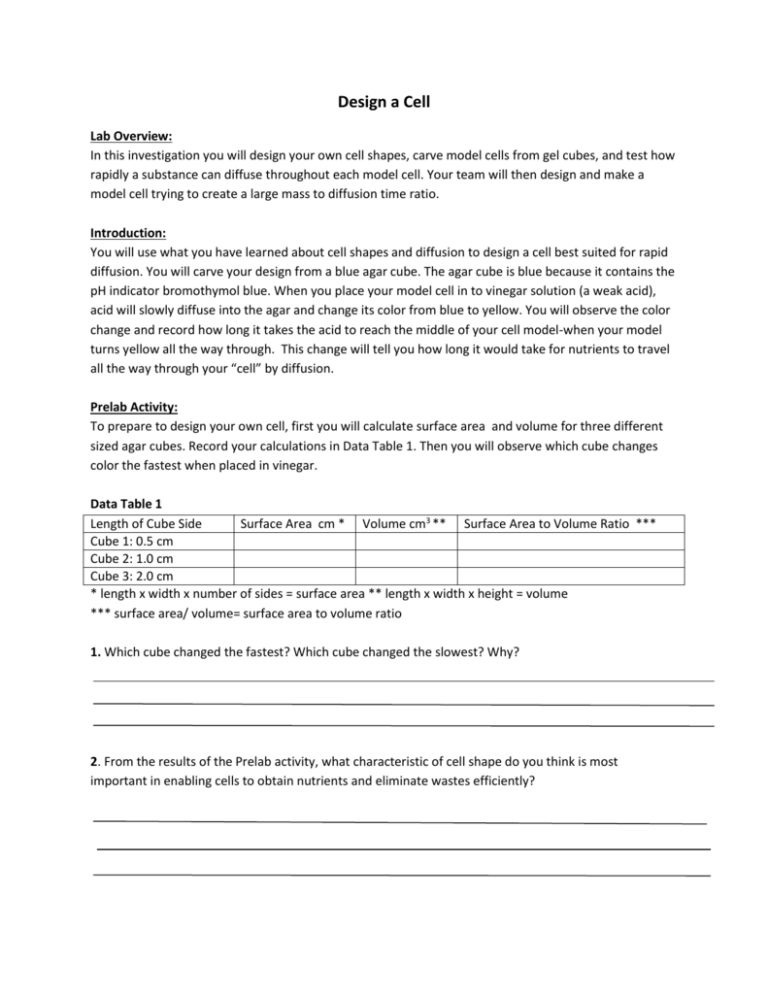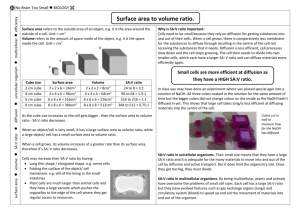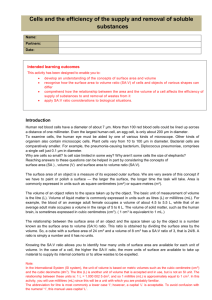Design a Cell - Learning2 eSchool
advertisement

Design a Cell Lab Overview: In this investigation you will design your own cell shapes, carve model cells from gel cubes, and test how rapidly a substance can diffuse throughout each model cell. Your team will then design and make a model cell trying to create a large mass to diffusion time ratio. Introduction: You will use what you have learned about cell shapes and diffusion to design a cell best suited for rapid diffusion. You will carve your design from a blue agar cube. The agar cube is blue because it contains the pH indicator bromothymol blue. When you place your model cell in to vinegar solution (a weak acid), acid will slowly diffuse into the agar and change its color from blue to yellow. You will observe the color change and record how long it takes the acid to reach the middle of your cell model-when your model turns yellow all the way through. This change will tell you how long it would take for nutrients to travel all the way through your “cell” by diffusion. Prelab Activity: To prepare to design your own cell, first you will calculate surface area and volume for three different sized agar cubes. Record your calculations in Data Table 1. Then you will observe which cube changes color the fastest when placed in vinegar. Data Table 1 Length of Cube Side Surface Area cm * Volume cm3 ** Surface Area to Volume Ratio *** Cube 1: 0.5 cm Cube 2: 1.0 cm Cube 3: 2.0 cm * length x width x number of sides = surface area ** length x width x height = volume *** surface area/ volume= surface area to volume ratio 1. Which cube changed the fastest? Which cube changed the slowest? Why? 2. From the results of the Prelab activity, what characteristic of cell shape do you think is most important in enabling cells to obtain nutrients and eliminate wastes efficiently? 3. From this activity, what factor(s) do you think might limit cell size? 4. What happens to the surface area/volume ratio if you increase the volume of a cell? If you decrease the cell surface area? Would either of these approaches increase the rate of diffusion? Explain. 5. Consider other shapes for a cell besides a cube. What cell shape might increase the surface area and decrease the volume? Explain. Lab Using the provided question, design a lab to test for the cell shape that has the largest surface area to volume ratio. Provide a hypothesis, prediction, and procedure. After designing the lab, carry out your procedure. Use the provided data table to record your results. Question: What cell shapes are the most efficient at bringing in substances by diffusion? Plan and design a cell shape that you think will have a large surface area to volume ratio. Sketch your design in the space below. Use the design when writing your hypothesis and prediction. Hypothesis: Prediction: Materials: Agar cubes containing bromothymol blue Plastic knife Paper or plastic plate Beaker (100ml) Vinegar solution Stopwatch or clock with second hand Triple beam balance. *Your procedure should be written in numbered steps. It should be detailed enough that a person could follow it and perform the same experiment that you performed. Use the materials list given, the premade data table and the pre lab activity to help you design your experiment. Procedure: Data Table: Cell Shape Mass (g) Elapsed Time Mass/Time (g/min) Analysis and Conclusions: 1. How did your cell design compare to other groups? (If you worked alone see the data provided by the dry lab). 2. What were the characteristics of the model cell with the highest mass/time ratio? 3. Why are most cells microscopic? (hint it is not to fit in your body) What do you think limits cell size? 4. Look at the cells below, which one would have the largest surface area to volume ratio if they all had the same volume? a. b. c. 5. Which one of the cells shown in question 4 would change color most quickly in the experiment you just performed? Explain. 6. When a cell is very thin, flat or narrow, it can obtain nutrients more quickly. What possible disadvantages might there be to such a cell shape? Question for this lab were taken from: Campbell, Neil A., Brad Williamson, and Robin J. Heyden. "Investigative Lab 6."Biology: exploring life. Laboratory Manual ed. Needham, Mass.: Pearson :, 2004. 59-64. Print.




